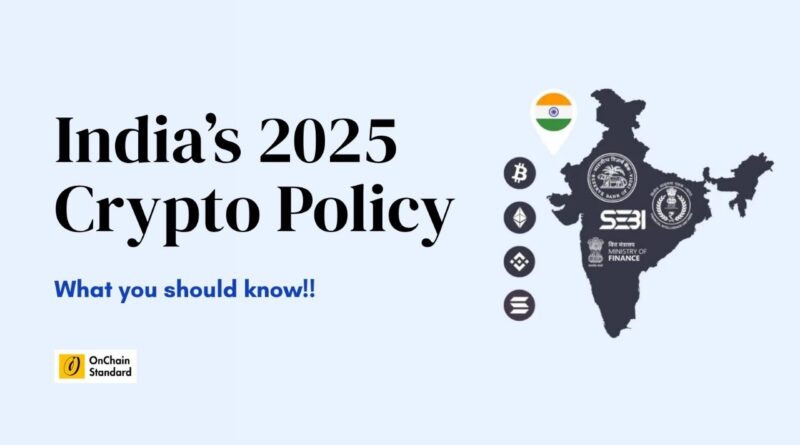India’s 2025 Crypto Policy: A Game-Changer for Cryptocurrency in India
India’s 2025 crypto policy, set for July, aims to regulate 107M users and a $6.4B market with clear rules, tax reforms, and Web3 growth
India’s 2025 Crypto Policy: A Game-Changer for Cryptocurrency in India
India’s cryptocurrency policy 2025 is set to revolutionize the digital asset landscape, with a discussion paper slated for release in July 2025. As one of the world’s top crypto markets, boasting 107 million crypto users and a $6.4 billion market, India is poised to balance innovation with investor protection. This article dives into the past events shaping this India crypto regulation, what the policy might include, and how global trends influence it. Packed with data and insights, this guide explores why the 2025 crypto policy is a must-watch for crypto enthusiasts, investors, and blockchain startups.
The Journey to India’s 2025 Crypto Policy: Key Milestones
India’s cryptocurrency regulation journey has been turbulent, marked by bans, court rulings, and growing adoption. Here’s a timeline of events leading to the India crypto policy 2025:
- 2013: RBI’s Initial Caution
The Reserve Bank of India (RBI) issued its first advisory on cryptocurrencies, warning about risks like volatility and fraud. This set a cautious tone for India’s crypto market. Learn more about RBI’s early stance. - 2017: Ponzi Scheme Fears
The Finance Ministry labeled cryptocurrencies as potential Ponzi schemes, reflecting early skepticism about Bitcoin and altcoins. This fueled uncertainty for Indian crypto investors. - 2018: RBI’s Banking Ban
In April 2018, the RBI banned banks from servicing crypto exchanges, crippling platforms like ZebPay and WazirX. Many businesses shut down or moved offshore due to this India crypto ban. Read about the RBI ban. - 2020: Supreme Court’s Landmark Ruling
In March 2020, the Supreme Court overturned the RBI ban, calling it disproportionate. This ruling revived India’s crypto industry, with exchanges like CoinDCX seeing a user surge. Explore the Supreme Court ruling. - 2021: Crypto Bill Sparks Debate
The proposed Cryptocurrency and Regulation of Official Digital Currency Bill, 2021 aimed to ban private cryptocurrencies while promoting a Central Bank Digital Currency (CBDC). Though it didn’t pass, it signaled intent for crypto regulation in India. - 2022: Crypto Taxation Hits Hard
The 2022 Union Budget introduced a 30% crypto tax and 1% TDS on transactions above ₹50,000. This legitimized crypto as an asset but reduced trading volumes by 40% since 2023, per industry reports. Understand India’s crypto tax. - 2023: FIU Targets Offshore Exchanges
In December 2023, the Financial Intelligence Unit (FIU) issued notices to nine offshore exchanges, including Binance, for non-compliance. Binance faced a ₹188.2 million ($2.25 million) fine in June 2024 after registering with the FIU. - 2024: Global Shifts Prompt Policy Review
In July 2024, India announced plans for a crypto policy discussion paper, delayed from September due to global trends like the U.S.’s pro-crypto policies under President Trump. Read about global crypto trends. - 2025: SEBI and Multi-Agency Oversight
On April 1, 2025, SEBI began monitoring crypto tokens resembling securities. On February 10, 2025, exchanges became “reporting entities” under AML guidelines, mandating transaction transparency. Learn about SEBI’s role.
These events highlight India’s cautious yet evolving approach to cryptocurrency regulation, driven by concerns over fraud, financial stability, and the rise of 107 million crypto users in 2025. And even today Indian Government doesn’t see Crypto with positive lenses, and is adamant on banning the ecosystems related to crypto.
Why Is India Crafting a Crypto Policy in 2025?
Several factors have pushed India toward a comprehensive crypto policy:
- Massive Crypto Adoption
India leads globally with 107 million crypto users in 2025, per Statista, despite high taxes. Platforms like CoinDCX, WazirX, and ZebPay report record growth, necessitating clear India crypto laws. Explore India’s crypto adoption. - Global Policy Influence
The U.S.’s pro-crypto policies, including a 200,000 BTC reserve and stablecoin legislation, have pressured India to align. Pakistan and Bhutan’s Bitcoin reserve announcements in 2025 also inspire calls for similar strategies in India. - Supreme Court’s Push
The 2020 Supreme Court ruling and 2025 reiterations emphasize balanced crypto regulation to protect investors without stifling innovation. - RBI’s Digital Rupee
The Digital Rupee, piloted by the RBI, reflects India’s blockchain interest. The 2025 crypto policy may integrate CBDCs with regulated markets. - Industry Advocacy
Exchanges like CoinDCX and Binance, alongside events like the India Blockchain Tour 2025, push for progressive policies. Sumit Gupta, CoinDCX CEO, tweeted, “Let’s make India the Web3 capital!” Follow CoinDCX updates.
“Also read article about – Top Crypto-Friendly Countries to Incorporate Your Web3 Startup in 2025“
What Will the 2025 Crypto Policy Cover?
The India crypto policy 2025, expected in July, will draw from IMF-FSB frameworks and public feedback. Likely areas include:
- Clear Asset Definitions
Classifying Bitcoin, stablecoins, altcoins, and NFTs under Section 2(47A) of the Income Tax Act for streamlined taxation and regulation. - Stablecoins for Remittances
Leveraging India’s $100 billion remittance market, stablecoins could reduce costs for cross-border payments. - Tax Reforms
The 30% crypto tax and 1% TDS may see changes, like allowing loss set-offs, to boost trading. Standardized reporting via Schedule VDA in ITR forms will likely persist. - Multi-Agency Regulation
A framework involving RBI, SEBI, and the Finance Ministry could oversee crypto exchanges, DeFi, and tokens, ensuring KYC/AML compliance. - Regulatory Sandbox
A sandbox for blockchain startups to test innovations under oversight could drive growth. - Investor Protection
Mandatory disclosures, anti-fraud measures, and capital adequacy rules to safeguard Indian crypto investors. - Sustainability Focus
Incentives for energy-efficient blockchains (e.g., Proof-of-Stake) and restrictions on high-energy mining to align with global sustainability goals.
How Do Global Policies Impact India’s Crypto Approach?
India’s cryptocurrency policy is shaped by global trends due to crypto’s borderless nature. Key influences include:
- U.S. Pro-Crypto Shift
The U.S.’s Bitcoin reserve, STABLE Act, and Crypto Task Force under Paul Atkins (SEC) push India to adopt competitive crypto regulations. - Pakistan and Bhutan’s Moves
Pakistan’s 2025 Bitcoin reserve and Bhutan’s state-run mining model inspire leaders like BJP’s Pradeep Bhandari to propose a similar pilot in India. - G20 and IMF-FSB Frameworks
India’s G20 presidency in 2023 emphasized global crypto standards. The FSB’s October 2025 review guides India’s focus on financial stability and anti-illicit measures. - Contrasting Models
Crypto-friendly hubs like the UAE and Singapore contrast with India’s high taxes, urging a balanced approach to retain investors.
A restrictive policy risks pushing users to unregulated platforms, while a progressive one could attract global investment, as noted by Economic Affairs Secretary Ajay Seth.
Why India’s Crypto Policy Matters
The 2025 crypto policy could make India a Web3 leader, leveraging its 107 million crypto users and $6.4 billion market. Clear rules will boost investor confidence, reduce scams, and attract blockchain startups. For everyday Indians, it means safer trading, potential crypto tax relief, and access to tools like the Digital Rupee or tokenized assets.




